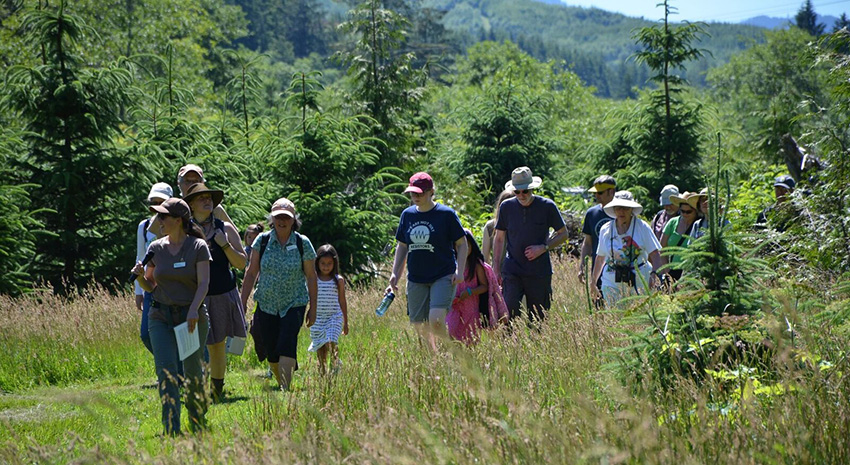Founding executive director Neal Maine looks back 15 years to when North Coast Land Conservancy acquired Circle Creek—and almost didn’t.
By the time North Coast Land Conservancy had been in existence for 10 years, it had conserved a total of six properties, none of them larger than 6 acres. By 2002, when Seaside farmer Russ Earl cornered Neal Maine at Lazerquick one day and suggested that NCLC buy Russ’s 364-acre farm at the foot of Tillamook Head, NCLC’s biggest property was smaller than 20 acres. Neal, then NCLC’s part-time director and sole employee, and the board quickly grasped the potential: the chance to reforest a vast floodplain forest a stone’s throw from Ecola State Park and other conserved lands, right at the edge of Seaside. But how? It was going to cost more than $1 million. Never had NCLC raised anywhere near that much money, or attempted a project approaching that level of complexity.
Major funders quickly jumped on board. As soon as Neal led representatives of the Oregon Watershed Enhancement Board and the US Fish and Wildlife Service on a walk of the property—long a dairy farm, then a cattle ranch, bisected by meandering Circle Creek—they had agreed to jointly fund about half the asking price. All NCLC had to do was raise the other half-million dollars.

That’s when things got rough. The board split over whether to take on the challenge. They had no experience raising serious money or managing a property that large. Seaside High School cheerleaders were donating their weekend car-washing money toward the project—but no amount of car wash donations was going to get NCLC to the finish line. On top of that, a state senator from southern Oregon took aim at the project, proposing a bill to prohibit private conservation of farmland if it took the land out of production.
“There was so much human activity—talk, talk talk, paper, paper, paper,” Neal recalls. “You get so caught up with human activities—leases and funding and rules—then pretty soon you kind of end up forgetting, what is the point of this?” It all came to a head one Thursday. OWEB needed to know by Monday if NCLC was committed to raising the matching funds: yes or no.

The next day Neal drove out to Circle Creek. He parked between the barns and followed the farm road north to where an alder grove served as a portal to a forest of venerable spruce. He began walking among the trees, just being in the forest, seeing the forest: the spruce roots that spread out like octopus arms, above the ground; the nurse logs and cut stumps nurturing one or a half-dozen trees; the red-legged frogs disappearing with a leap into the undergrowth; the skunk cabbage growing in a bog created by a windfall spruce; the orange shelf fungus now growing on those spruce roots. And the alders, and their role in the forest’s on-going process of renewal: “They don’t make enough money for what this alder grove is going to produce day after tomorrow,” as Neal put it. “You can’t buy that anywhere, and you can’t invent it. This is it.”
Years earlier Neal had read an article titled “My Psychologist,” in which the author described what a good listener his psychologist was, how much help the author always got from a visit to his psychologist. The punch line: his “psychologist” was actually a tree.

The point, Neal realized—or remembered, that day in the forest—was that to the conservancy, acquisition of Circle Creek wasn’t merely a real estate transaction. It was an investment: an opportunity to allow this landscape, next to a city, at the foot of an iconic headland, to thrive and benefit everything that lived on and near it—people, plants, and wildlife—forever.
Monday morning Neal picked up the phone and called the OWEB office in Salem.
“This land isn’t worth a million dollars,” he said. “It’s worth a billion.”

With the project’s vision back in focus, donors began showing up and chipping in: local businesses, hunting and fishing groups, and dozens of individual donors. “We made so many friends,” Neal says. In July 2004, NCLC took title to the land at Circle Creek.
That fall the conservancy held a dedication ceremony. The seller, Russ Earl, was there with his daughter, and a cluster of board members and other friends of the conservancy. So was the OWEB director, accompanied by his young sons. Or former director; his commitment to helping fund conservation of the Circle Creek property had ultimately cost him his job. But he had no misgivings. He was there to celebrate what he had helped accomplish for the community, and for Oregon, and for his own children, and their children.
“That was more of a validation to me than anything else,” Neal recalls. “When you come down to it, it’s the people who are going to make these things happen.
“No matter what the land’s telling us, it’s the people.”

More about Circle Creek:
Property profile
Circle Creek Conservation Center
On the Land events
Comments